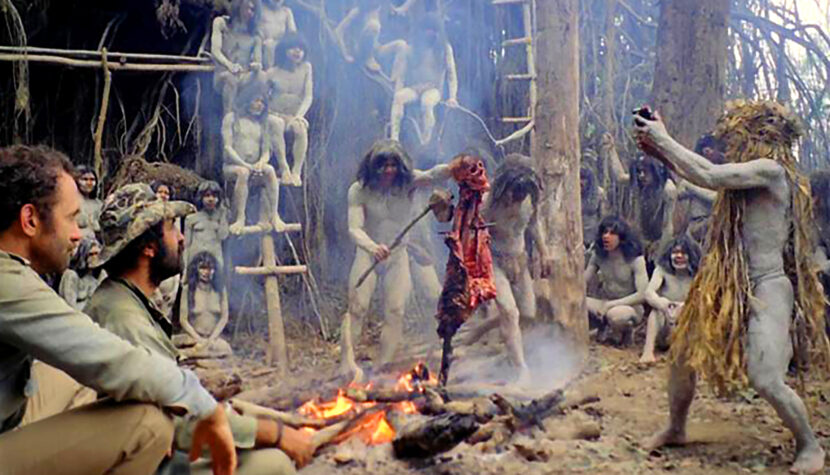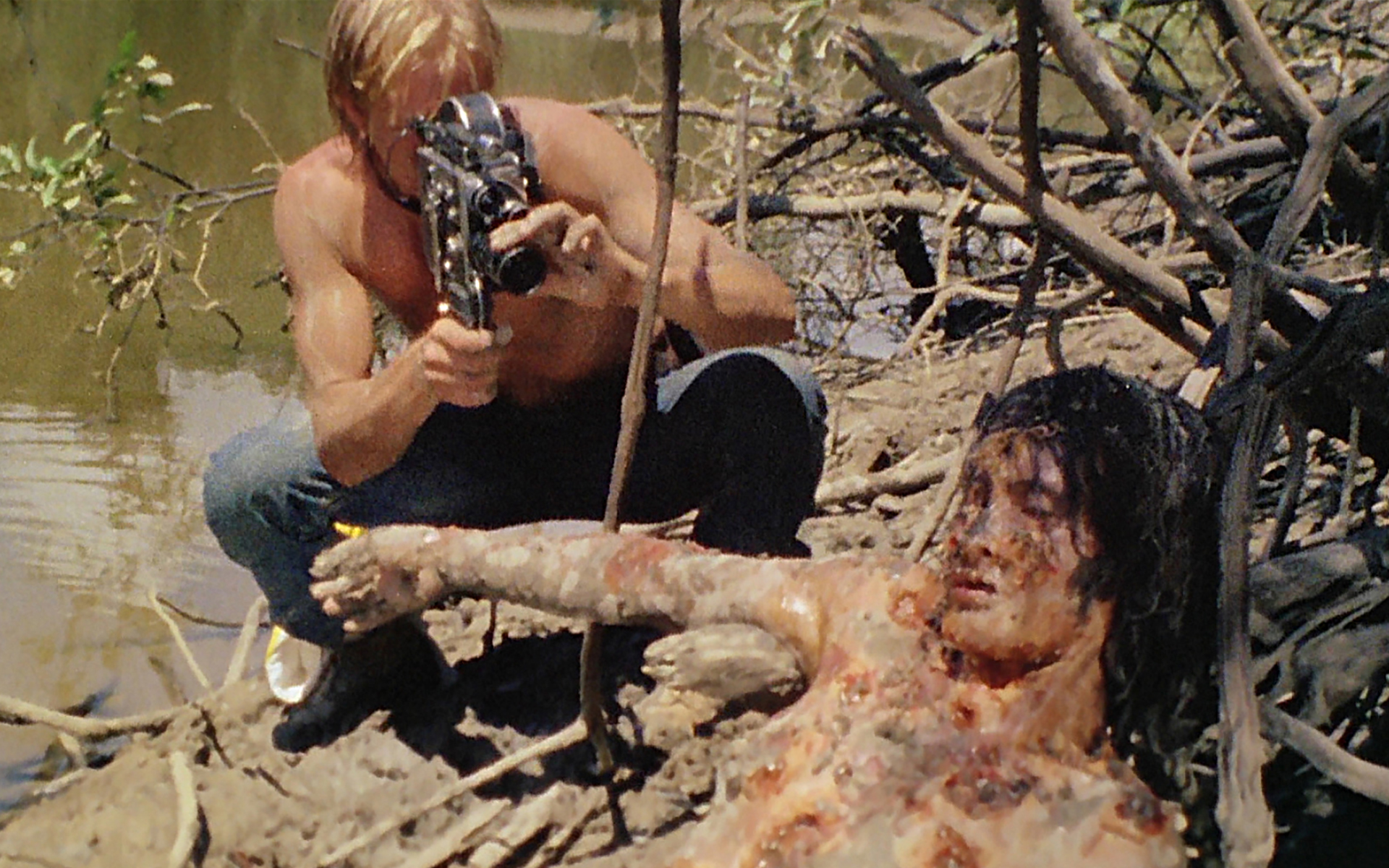CANNIBAL HOLOCAUST. The most brutal movie ever filmed

The director brilliantly separated this concept of HUMAN as a subjective category to be assessed from races, morality and all cultural principles. Only then can you find out who people are when they realize that the world is their sandbox, they can do whatever they want in it and no one will ever punish them for it.
Cliché?
Now let’s start from the beginning, so that at least one tenth of this text fits into the criteria of film studies. For those who have never seen Cannibal Holocaust, the content of the film may turn out to be quite schematic. Because here are some filmmakers crazy about realistic documentary filmmaking, headed by director Alan Yaters, set off to the Colombian jungle to investigate tribes of cannibals separated from civilization and in conflict with each other (Yacumo, Yanomamo, Shamatari). As it happens in horror films, all traces of them disappear. Professor of anthropology Harold Monroe, together with experienced guides Chaco and Miguel, sets out to search for the missing. What he finds, i.e. tapes recorded by reporters from their trip to the Amazon jungle, will shock him tremendously and make him seriously think about who really is the real barbarian in the modern world.
The content of Cannibal Holocaust seems a bit clichéd, but it’s about the visual form, not philosophical dialogues. In fact, it is known from the beginning that the missing filmmakers are dead. The perpetrators are also known. They were murdered by savage and pagan Indians. Only the motives remain unclear. According to Deodato, however, it would be a great simplification to throw a slogan – journalists were eaten by cannibal Indians, because they are savages and do not know the rules of the civilized world.

Deodato tries to debunk the myth prevailing in the Western way of thinking, according to which the tendency to do harm to others depends on the level of culture, general technical civilization and the ability to think abstractly. The director speaks directly. The fact that someone knows the alphabet, learned to wear breathable knickers every day, officially has only one mistress and does not wring chickens’ heads with his own hands, does not affect his natural inclination to murder fellow species, especially when the right conditions are created for it. We live in a world no less mythologized than the ancient Spartans. Our myths, however, are not based on a polytheistically constructed reality, but are a culturally programmed vision of what modern man should be like. One God, one wife, and a pile of skulls under the carpet, which belong to the victims, who, after all, were never killed by their own hands. They were taken by the system, bad food, corporate stress, God and other confusing causes. In Freud’s language, we believed and then became addicted to the feeling that the socially imposed superego is the essence of who we are. Savage is not the one who kills, but the one who cannot understand that he does it for fun and without biological justification.
Beefsteak dripping with blood
To prove his thesis, Deodato served the viewer a beefsteak dripping with blood on a 16-mm tape. He decided that only such powerful stimuli as the murder of living beings on the screen could shake people out of their cultural numbness. Unfortunately, if he was counting on commercial success (which I doubt), he was wrong. He made cinema in line with the cannibalistic trend, a generally hated, niche and even forbidden direction in the Italian cinematography of the 1970s and 1980s. Viewers reacted to Cannibal Holocaust with irrational fear. They should have slapped the meat right in the face, but apparently not that hard. Deodato had to reckon with the fact that most viewers would not understand the film anyway. However, he might have been surprised by being prosecuted and banned from showing the film in dozens of “civilized” countries. The camera operator, Sergio D’Offizi, was also harassed. What populist, hypocritical propaganda.

I was really shaken by Deodato. At first, of course, all my anger focused on him as a licentious HUMAN, pseudo-artist and son of a bitch – that’s what I called him, and the actors even worse. Why the hell did he allow animals to be murdered on screen? Couldn’t it be otherwise? Did he have to take so much care of the formal aspect of his work? I can still hear the scream of the koati being cut alive in my ears. The toddler resisted the knife for a long time. He fought because he felt both pain and death. It was a display of needless cruelty, just like the mistreatment of Indians performed by sensationalist missing reporters. Now that the emotions have subsided a bit, I understand that the situation of the animals in Cannibal Holocaust is parallel to the fate of the inhabitants of the jungle.
The next victim, a tortoise, couldn’t say anything at the moment, although its legs still moved for a long time after the decapitation. The pig died faster, but was kicked first, because it was necessary to show the superiority of white skin. Cutting open the monkey’s skull is also impressive, although in this case the camera is hidden in the bushes and shakes a lot. This procedure called found footage is to increase the realistic drama throughout the film by simulating the documentary form of production. Compared to it The Blair Witch Project is like eating vanilla ice cream, while the neighbor at the next table has already ritually smeared himself with tartare, which smells like stale blood, and is still happy about it.
Realism
Thanks to the scenes quoted above, I was reminded of the cow from the first part of the mondo documentary Mondo cane, made in 1962 by three directors, Paolo Cavara, Gualtiero Jacopetti and Franco Prosperi. The animal is decapitated with a kukri knife in honor of the heroic Ghurki soldiers who would rather be decapitated by the Japanese than betray Great Britain. The cow does not know much about human betrayals and the concept of heroism, but nevertheless it is mercilessly used as a sacrificial symbol. Blood gushes in all directions, the head separates from the trembling torso, dragging bits of sinew and splinters of bone from the spine, and the audience, which is not only locals, but also the cream of the British army, is delighted with the ceremony. A barbaric comrades, only military-shaven, in starched shirts, with officers’ insignia. I wanted to puke.
It was this level of realism that inspired Deodato when shooting Cannibal Holocaust. I know why. He wanted to awaken my two-faced, Western-cultured anger. Because I eat these cutlets. I also have a personally killed chicken for broth and I have a pigeon on my conscience too. I think even if he was making a movie today, Deodato would kill those animals for real. Like a cunning viper, he would count on awakening the biological instinct in the viewer, which unmistakably senses death.

Comparing scenes of raping and killing people with killing animals, even when I didn’t know all the controversial background of the film, I was able to recognize what was real and what was acting. I don’t understand why people thought Deodato actually murdered the actors on set. Just watch the rape scenes carefully. The movements of the Indian actors are almost sluggish, the contact of the rapist’s hips with the victim’s hips makes penetration virtually impossible (unless with a horse-sized member), and sometimes the attacker moves away so much that it is perfectly clear that there is no rigid tool between the legs that would allow sexual violence.
It’s the same with the scenes of killing and cannibalism. The meat on the bones looks somehow rubbery, just like in Peter Jackson’s Brain Dead. The blood flows out of the way you’d expect due to the damage to the major arteries, cutting the flesh from the body of the sternum to the abdomen with stone axes looks like playing with strawberry pudding. It is impossible to believe that all this is really happening, because cheap special effects were used, based on a very sketchy understanding of human anatomy. All right. I admit that I watched the woman impaled several times and very carefully on a 65-inch screen. In this one case, I might actually be fooled.
Suffering and agony
However, when it comes to animals, I simply know that they die and suffer. I can’t justify this shivering sensation. I just know it. And I found out after the screening that they really died in the film. And all this to the disarming, candy music of Rizo Ortolani countering the idiotically bloody form of photos of murders, rapes and guts flying around the frame. This music doesn’t soften anything. It clearly shows the immorality of people’s actions in the “green hell”. The world of the Indians lies beyond good and evil, and we whites have come to their home to take that freedom from them because we envied it immensely.

The Indian broadly speaking is a national category related to culture, while the HUMAN is a representative of the species who, above all, wants to survive, and then to live pleasantly, and for such a life he will do everything that theoretically does not fit in a humanistic culture. The Indian can also become human, but the MAN of the West took away this right from him. An Indian is able to kill HUMANS but doesn’t know about it, because HUMANs make them believe that Indians can only be victims. And when they sometimes manage to jump out of line and scratch their executioners, they suddenly become savages destined for extermination.
I felt an almost physical pain while watching Deodato’s movie. I remembered a situation from over thirty years ago, when I was a baby who really wanted to belong to a group of strong, self-confident peers and was just an emaciated blonde and terrified of being the victim of a class holocaust. There was this Waldo. His parents really wanted him to study with “normal” children. Waldo, however, was different, behind. He reacted more slowly. He didn’t interact. He couldn’t handle it. He had to take the place in the educational system meant for people like him. But before that, there was a kind of fight for this child. My parents fought. They thought that contact with us, i.e. those with a satisfactory IQ, would help Waldo.

However, it happened that they brought Waldo to hell. I remember, like it was yesterday, kneeling in front of him and handing him the toy. I am looking for his acceptance and interest, because in my childhood I have not yet realized who Waldo will never be. Once I know that, I hit him, I bite him, I take his toys away, I do what everyone else does. I know that if I behaved differently, I would start to belong to a group that has no chance to cope – a meat to eat, as in Cannibal Holocaust. I don’t want to be eaten, so I take the place of a HUMAN and ignite the Jew, butcher the Indian, reduce Waldo to the only possible role for him – the victim.


